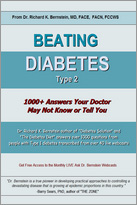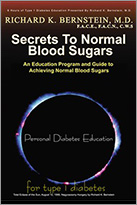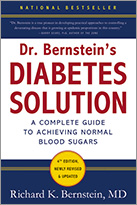SYMLIN: SYNTHETIC HUMAN HORMONE AMYLIN
A new tool for the treatment of diabetes should be available around the time this book is published, or shortly thereafter. Symlin (pramlintide acetate), the brand name for Amylin Pharmaceuticals’ synthetic version of the human hormone amylin, has not yet come to market and I have not used it, but the literature is quite intriguing, particularly as it applies to the treatment of type 2 diabetes. You may not have heard of amylin before, but it plays an important role in the stabilization of postprandial blood sugars in nondiabetics. Natural amylin is not water soluble and therefore has not been useful as a medication for diabetes. This new synthetic amylin analog is water soluble.
One unit (1/100 cc) of the injectable insulin that I use is such a small volume that many older folks, like me, or others with impaired vision, cannot measure it without visual aids, such as my bifocals. Yet this minute amount will lower my blood sugar by 40 mg/dl. Since the insulin in my vial has been diluted 25 times, 1 unit of the real stuff, as produced by the pancreas, would lower me 25 x 40 mg/dl, or 1,000 mg/dl. In other words, insulin is powerful stuff.
Blood sugar cannot be controlled by such a powerful substance alone, so the body makes several less powerful hormones to fine-tune the net effect. One of these hormones is glucagon, which is much less potent than insulin but is secreted in larger amounts to prevent blood sugar from dropping too low in response to secreted insulin. In the nondiabetic, these hormones—insulin and its helpers—go about this balancing act unseen.
Another of these fine-tuning hormones is amylin. This hormone is produced in the same beta cells of the pancreas that produce insulin, but it seems to be more of a regulatory adjunct to glucagon than to insulin. That is to say that it seems to fine-tune the fine-tuner glucagon.
When food empties from the stomach and enters the intestines, in nondiabetics the slight distention of the intestines causes them to produce hormones that stimulate the pancreas to release other hormones.
In effect, they signal the pancreas, “Hey! There’s food on the way, get some insulin out here before blood sugar goes up!” The beta cells of the pancreas then release insulin, as well as replenish what’s being released to keep up with demand. Since insulin is so powerful, the alpha cells make glucagon to offset insulin and fine-tune blood sugar more precisely. The same beta cells that make insulin also produce amylin to reduce the liver’s response to glucagon, thereby achieving even more precise control.
Amylin also slows the rate at which the stomach empties, causing a sustained sense of fullness, or satiety, and in turn inhibiting overeating that might overwhelm the ability of insulin to control blood sugar. By inhibiting both the Chinese restaurant effect and overeating, amylin has particular usefulness in the treatment of type 2 diabetes. Because it indirectly diminishes the need for insulin, it provides the individual with the opportunity to rest exhausted beta cells and to lose weight (insulin, you’ll recall, is the main fat-building hormone).
Symlin amylin analog can only be taken by injection. It should be administered 15 minutes before meals. It is provided in a slightly acid preparation that may cause a burning sensation upon injection. The dosing used for type 2 diabetics in recent clinical trials required a large injection (by my standards—1/5 cc, or 20 units on an insulin syringe). This is three times the volume of the largest single insulin injection my insulin-requiring patients administer and brings the possibility of discomfort at injection sites.
I foresee the action of amylin as most beneficial for type 2 diabetics. It’s been my experience that most type 1s who’ve had the disease for more than five years or so have some degree of gastroparesis, or delayed stomach-emptying. I anticipate a reasonable likelihood that type 1 diabetics with gastroparesis would experience more difficulty with blood sugar control, rather than less, if they were to use this product. If you are taking insulin and your physician wants you to try Symlin, he should start the medication at a very low dose and slowly increase dosing while lowering premeal insulin doses if your blood sugars indicate that it’s necessary. The slow tapering up of the Symlin dose should reduce the likelihood of its most common side effect— nausea—and also the likelihood of hypoglycemia as less injected insulin becomes necessary.




